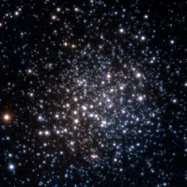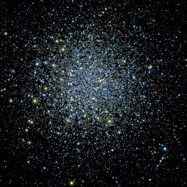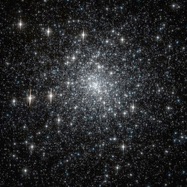






Paper LXI
Weighing stars: the identification of an Evolved Blue Straggler Star in the globular cluster 47 Tucanae
Ferraro F. R., Lapenna E., Mucciarelli A., Lanzoni B., Dalessandro E., Pallanca C., Massari D.
Globular clusters are known to host peculiar objects, named Blue Straggler Stars (BSSs), significantly heavier than the normal stellar population. While these stars can be easily identified during their core hydrogen-burning phase, they are photometrically indistinguishable from their low-mass sisters in advanced stages of the subsequent evolution. A clear-cut identification of these objects would require the direct measurement of the stellar mass. We used the detailed comparison between chemical abundances derived from neutral and from ionized spectral lines as a powerful stellar "weighing device" to measure stellar mass and to identify an evolved BSS in 47 Tucanae. In particular, high-resolution spectra of three bright stars located slightly above the level of the "canonical" horizontal branch sequence in the color-magnitude diagram of 47 Tucanae, have been obtained with UVES spectrograph. The measurements of iron and titanium abundances performed separately from neutral and ionized lines reveal that two targets have stellar parameters fully consistent with those expected for low-mass post-horizontal branch objects, while for the other target the elemental ionization balance is obtained only by assuming a mass of ~1.4Msol, which is significantly larger than the main sequence turn-off mass of the cluster (~0.85 Msol). The comparison with theoretical stellar tracks suggests that this is a BSS descendant possibly experiencing its core helium-burning phase. The large applicability of the proposed method to most of the globular clusters in our Galaxy opens the possibility to initiate systematic searches for evolved BSSs, thus giving access to still unexplored phases of their evolution.
This paper has been published in the Astrophysical Journal (2016, ApJ, 816, 70). A PDF copy of the preprint is also available on the astro-ph server at this address arXiv:1512.00649
2016





Paper LXII
NGC 6362: the least massive globular cluster with chemically distinct multiple populations
Mucciarelli A., Dalessandro E., Massari D., Bellazzini M., Ferraro F. R., Lanzoni B., Lardo C., Salaris M., Cassisi S.
We present the first measure of Fe and Na abundances in NGC 6362, a low-mass globular cluster where first and second generation stars are fully spatially mixed. A total of 160 member stars (along the red giant branch and the red horizontal branch) have been observed with the multi-object spectrograph FLAMES at the Very Large Telescope. We find that the cluster has an iron abundance of [Fe/H]=-1.09 \pm 0.01 dex, without evidence of intrinsic dispersion. On the other hand, the [Na/Fe] distribution turns out to be intrinsically broad and bimodal. The Na-poor and Na-rich stars populate, respectively, the bluest and the reddest red giant branches detected in the color-magnitude diagrams including the U filter. The red giant branch is composed of a mixture of first and second generation stars in a similar proportion, while almost all the red horizontal branch stars belong to the first cluster generation. Until now, NGC 6362 is the least massive globular cluster where both the photometric and spectroscopic signatures of multiple populations have been detected..
This paper has been published in the Astrophysical Journal (2016, ApJ, 824, 73). A PDF copy of the preprint is also available on the astro-ph server at this address arXiv:1604.04151
Paper LXIII
The age of the young bulge-like population in the stellar system Terzan5: linking the Galactic bulge to the high-z Universe
Ferraro F.R., Massari D., Dalessandro E., Lanzoni B., Origlia L., Rich R.M., Mucciarelli A.
The Galactic bulge is dominated by an old, metal rich stellar population. The possible presence and the amount of a young (a few Gyr old) minor component is one of the major issues debated in the literature. Recently, the bulge stellar system Terzan 5 was found to harbor three sub-populations with iron content varying by more than one order of magnitude (from 0.2 up to 2 times the solar value), with chemical abundance patterns strikingly similar to those observed in bulge field stars. Here we report on the detection of two distinct main sequence turn-off points in Terzan 5, providing the age of the two main stellar populations: 12 Gyr for the (dominant) sub-solar component and 4.5 Gyr for the component at super-solar metallicity. This discovery classifies Terzan 5 as a site in the Galactic bulge where multiple bursts of star formation occurred, thus suggesting a quite massive progenitor possibly resembling the giant clumps observed in star forming galaxies at high redshifts. This connection opens a new route of investigation into the formation process and evolution of spheroids and their stellar content.
This paper has been published in the Astrophysical Journal (2016, ApJ, 828, 2). A PDF copy of the preprint is also available on the astro-ph server at this address arXiv:1609.01515
Paper LXII
Searching in the dark: the dark mass content of the Milky Way globular clusters NGC 288 and NGC 6218
Sollima A., Ferraro F.R., Lovisi L., Contenta F., Vesperini E., Origlia L., Lapenna E., Lanzoni B., Mucciarelli A., Dalessandro E., Pallanca C.
We present an observational estimate of the fraction and distribution of dark mass in the innermost region of the two Galactic globular clusters NGC 6218 (M12) and NGC 288. Such an assessment has been made by comparing the dynamical and luminous mass profiles derived from an accurate analysis of the most extensive spectroscopic and photometric surveys performed on these stellar systems. We find that non-luminous matter constitutes more than 60% of the total mass in the region probed by our data (R<1.6 arcmin~rh) in both clusters. We have carefully analyzed the effects of binaries and tidal heating on our estimate and ruled out the possibility that our result is a spurious consequence of these effects. The dark component appears to be more concentrated than the most massive stars suggesting that it is likely composed of dark remnants segregated in the cluster core.
This paper has been published in the Monthly Notices of the Royal Astronomical Society (2016, MNRAS, 462, 1937). A PDF copy of the preprint is also available on the astro-ph server at this address arXiv:1607.05612

